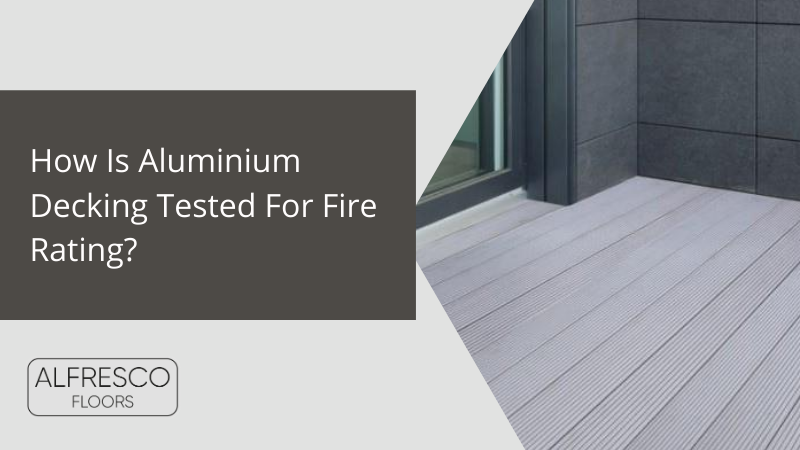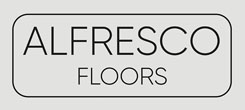
17 Aug How Is Aluminium Decking Tested For Fire Rating?

There are many materials you could choose to build an external flooring application, from porcelain, concrete and natural stone.
In its untreated form, aluminium is non-combustible. In terms of the Euroclass fire-rating system, this means that it would be given a Class A rating.
However, there are a number of ways that manufacturers can actually decrease the fire rating of their aluminium decking.
Applying a powder coating or a slip-resistant material such as rubber onto the aluminium deck board could potentially increase the chances of the decking catching fire; bad news if you’re working on a ‘specified attachment’ above 18 metres in height.
In this post, we’ll cover how materials such as aluminium are tested for fire rating and how you can ensure non-combustibility within your product choice.
Fire Classification in the UK
When discussing a material’s reaction to fire classification, we use the labels ‘non-combustible, ‘limited combustibility’ and ‘combustible’.
In the UK, products have to undergo the BS 476 suite of tests which can be achieved through the National Classes. However, most construction materials also need a CE mark. This means that products must also be classified through the Euroclass system.
How Does The Euroclass System Work?
Aluminium is tested in the same way as all other construction materials. The Euroclass system categorises products from A1 (non-combustible) to F (highly-combustible).
Alongside this, the Euroclass system provides additional classification for smoke production and flaming droplets/particles.

What Does the Euroclass System Test Involve for Flooring?
- EN ISO 1182:2010 – Non-combustibility test
- EN ISO 1716:2018 – Determination of the gross heat of combustion (calorific value)
- EN ISO 9239-1 – Radiant panel test
- EN ISO 11925-2 – Single-flame source test/ignitability test
To view each individual test in further detail, head over to our detailed blog post on how materials are tested for fire rating here.
Is All Aluminium Decking Class A Rated?
Flat untreated aluminium may present a certain slip hazard due to its smooth surface. To overcome this, some manufacturers use slip-resistant rubber/composite inserts to reduce this risk.
Unfortunately, a rubber material compromises the material’s combustibility – reducing your chances of using it on any application above 18 metres.
As previously mentioned, if your aluminium decking remains un-tampered with, then yes, it will be naturally non-combustible.
Aside from incorporating rubber inserts, it is sometimes necessary to apply a coating to the aluminium during the manufacturing process in order to preserve the material’s longevity, to improve the overall aesthetic of the decking and to provide slip resistance.
At Alfresco Floors, our aluminium decking is coated with anti-slip resistance. Under the Euroclass fire testing system, it is class A2 rated. This means that, despite the use of a coating, our aluminium decking can still be used for specified attachments above 18 metres in height.
Conclusion: Aluminium is a Top Choice for your High-Rise Project
As a specifier working on a high-rise project, it’s crucial that the aluminium decking you choose provides ultimate safety for the end-user.
For the reassurance that your aluminium decking meets UK Fire Regulations, talk to Alfresco Floors about their unique aluminium decking solutions today.




Pingback:Alfresco Floors' Guide to Aluminium Decking - Alfresco Floors
Posted at 12:52h, 02 December[…] testing for fire classification for materials, they will be categorised as ‘non-combustible, ‘limited combustibility’ and […]
Pingback:What is Class A Decking? - Alfresco Floors
Posted at 12:42h, 07 December[…] For example, the Alfresco AR-system: AR-Pave and the sub-frame of AR-Deck is composed 100% of aluminium, and therefore does not require a fire safety test. As specialists in Class A fire-rated solutions, our products do not contribute to a fire at any stage – making them the safest option for your high-rise project. Check out how our aluminium decking is tested for fire rating. […]
Chris Charlton
Posted at 11:25h, 11 DecemberThe wording “As a natural material’ and ‘as a natural product’ here is not helpful in both instances; being a ‘natural’ material is totally irrelevant and is suggesting characteristics that are not applicable in other situations. For example, timber is a ‘natural material’ but does not mean it has a fire resistance or no slip resistance. What you mean is ‘In its natural form’ which would make a lot more sense in this context.